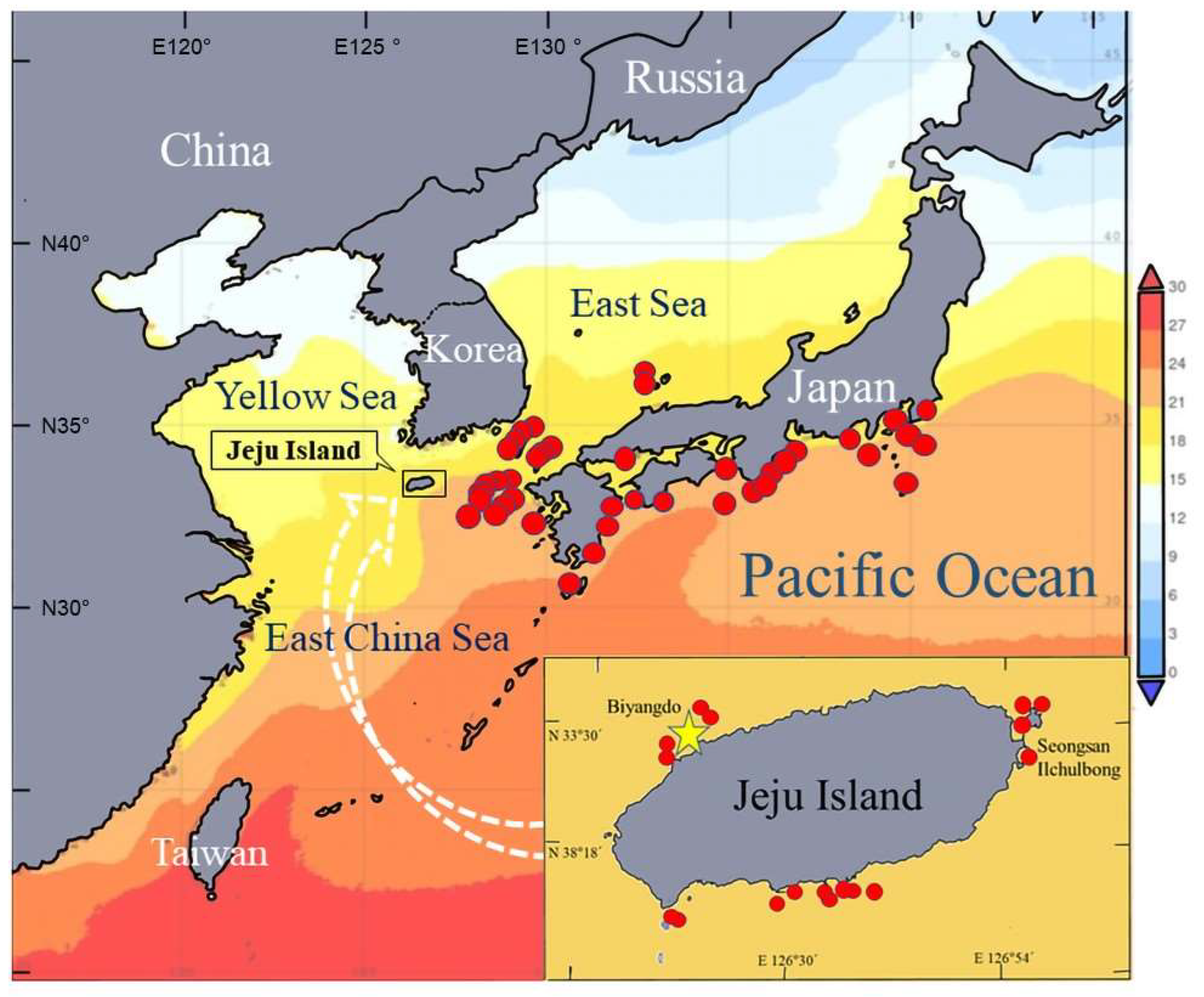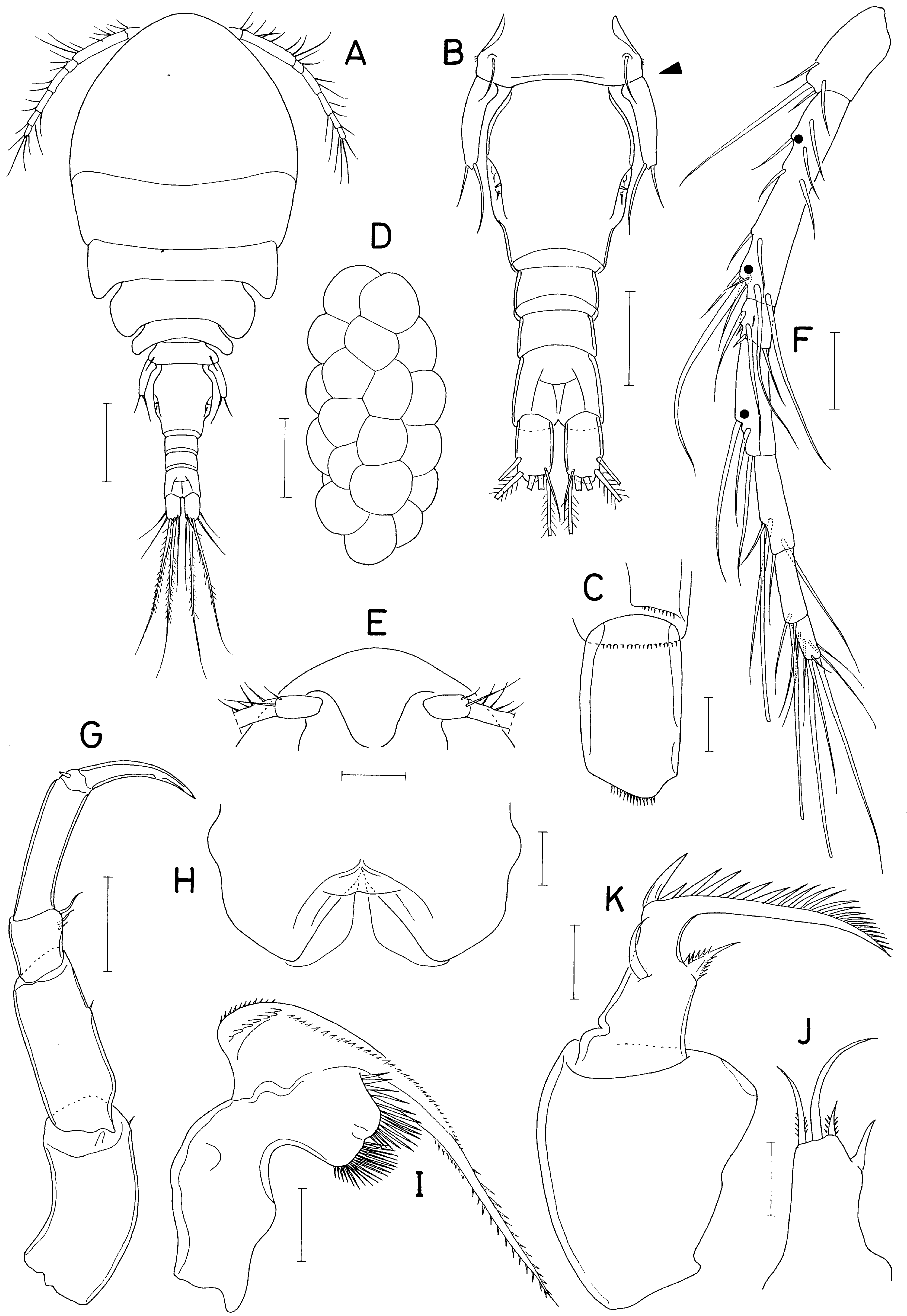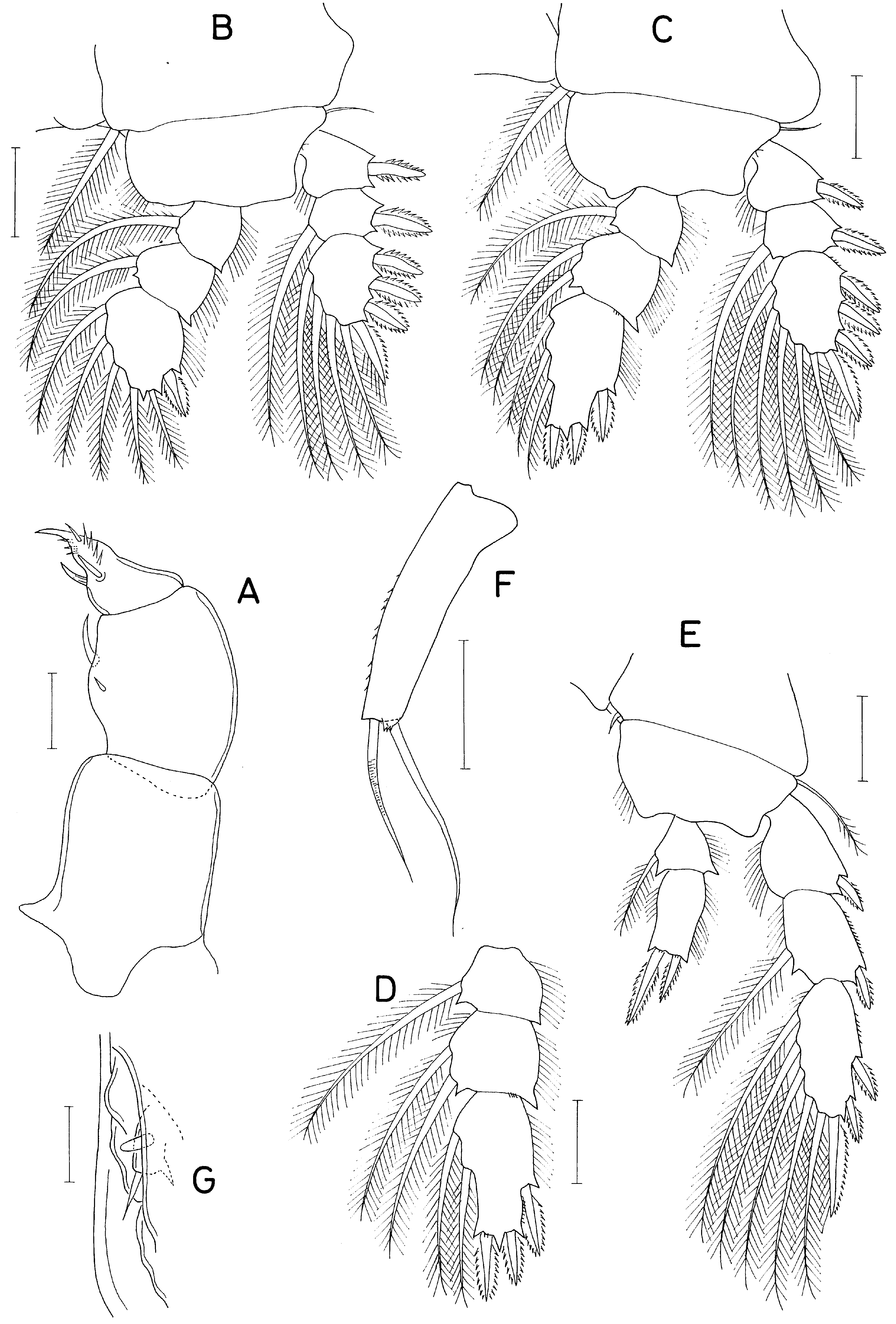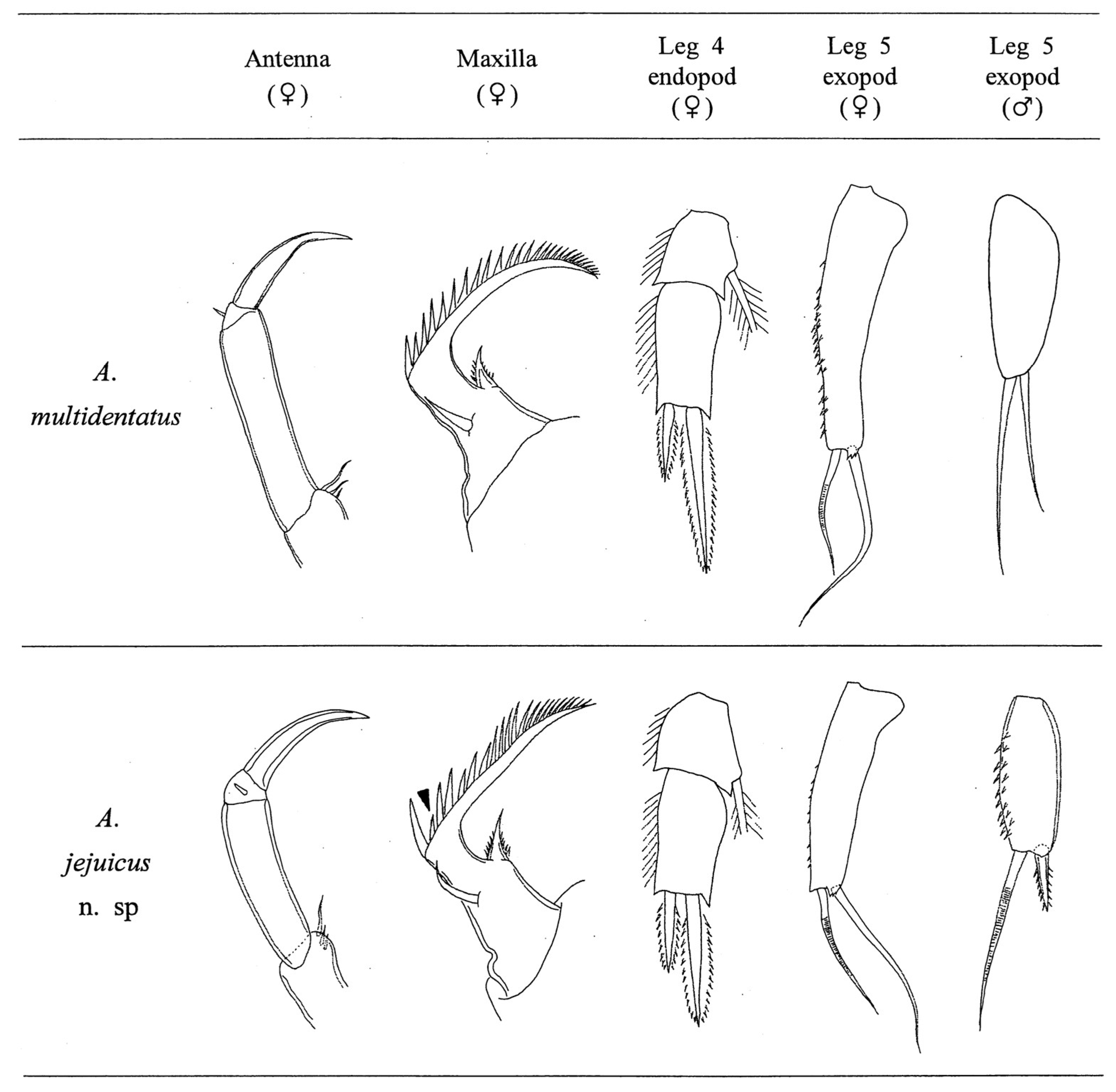Discovery of Anchimolgus jejuicus n. sp. (Copepoda, Cyclopoida, Anchimolgidae) Associated with the Scleractinian Coral Alveopora japonica Eguchi (Cnidaria) off Jeju Island, Korea: Systematics and Ecological Insights
Abstract
1. Introduction
2. Materials and Methods
3. Taxonomic Description
4. Discussion
4.1. Species Characterization
4.2. Ecological Implications of the Discovery of the Symbiotic Copepod Anchimolgus jejuicus n. sp. on the Scleractinian Coral Alveopora japonica from Jeju Island

Author Contributions
Funding
Data Availability Statement
Acknowledgments
Conflicts of Interest
References
- Huys, R. Chaper 27. Copepoda. In Atlas of Crustacean Larvae; Martin, J.W., Olesen, J., Høeg, J.T., Eds.; Johns Hopkins University Press: Baltimore, MD, USA, 2014; pp. 144–151, Figures 27-1–27-12. [Google Scholar]
- Boxshall, G.A. Chapter 4 Crustacean parasites—Copepoda (copepods). In Marine Parasitology; Rohde, K., Ed.; CSIRO Publishing: Collingwood, Australia, 2005; pp. 123–138. [Google Scholar]
- Humes, A.G.; Boxshall, G.A. A revision of the lichomolgoid complex (Copepoda: Poecilostomatoida), with the recognition of six new families. J. Nat. Hist. 1996, 30, 175–227. [Google Scholar] [CrossRef]
- Boxshall, G.A.; Halsey, A.H. An Introduction to Copepod Diversity; The Ray Society: London, UK, 2004; 966p. [Google Scholar]
- WoRMS Editorial Board. World Register of Marine Species. 2025. Available online: http://www.marinespecies.org (accessed on 14 April 2025).
- Humes, A.G. Cyclopoid copepods (Lichomolgidae) from fungiid corals in New Caledonia. Zool. Anz. 1973, 190, 312–333. [Google Scholar]
- Kim, I.-H. Copepods (Crustacea) associated with marine invertebrates from New Caledonia. Korean J. Syst. Zool. 2003, 4, 1–167. [Google Scholar]
- Kim, I.-H. Copepods (Crustacea) associated with marine invertebrates from the Moluccas. Korean J. Syst. Zool. 2007, 6, 1–126. [Google Scholar]
- Kim, I.-H. Siphonostomatoid Copepoda (Crustacea) associated with invertebrates from tropical waters. Korean J. Syst. Zool. 2010, 8, 1–176. [Google Scholar]
- Humes, A.G. How many copepods? Hydrobiologia 1994, 292/293, 1–7. [Google Scholar] [CrossRef]
- Denis, V.; Chen, C.A.; Song, J.I.; Woo, S. Alveopora japonica beds thriving under kelp. Coral Reefs 2013, 32, 503. [Google Scholar] [CrossRef]
- Vieira, C.; Keshavmurthy, S.; Ju, S.-J.; Hyeong, K.; Seo, I.; Kang, C.-K.; Hong, H.-K.; Chen, C.A.; Choi, K.S. Population dynamics of a high-latitude coral Alveopora japonica Eguchi from Jeju Island, off the southern coast of Korea. Mar. Freshw. Res. 2015, 67, 594–604. [Google Scholar] [CrossRef]
- Kang, J.H.; Jang, J.E.; Kim, J.H.; Kim, S.; Keshavmurthy, S.; Agostini, S.; Rimer, J.D.; Chen, C.A.; Choi, K.-S.; Park, S.R.; et al. The origin of the subtropical coral Alveopora japonica (Scleractinia: Acroporidae) in high-latitude environments. Front. Ecol. Evol. 2020, 8, 12. [Google Scholar] [CrossRef]
- Shin, S.; Ribas-Deulofeu, L.; Subramaniam, T.; Lee, K.T.; Kang, C.-K.; Denis, V.; Choi, K.-S. The vertical distribution of Alveopora japonica provides insight into the characteristics and factors controlling population expansion at Jeju Island off the south coast of Korea. Mar. Biodivers. 2024, 54, 20. [Google Scholar] [CrossRef]
- Humes, A.G.; Gooding, R.U. A method for studying the external anatomy of copepods. Crustaceana 1964, 6, 238–240. [Google Scholar] [CrossRef]
- Huys, R.; Boxshall, G.A. Copepod Evolution; Ray Society: London, UK, 1991; pp. 1–468. ISBN 0-903-87421-0. [Google Scholar]
- Stella, J.S.; Pratchett, M.S.; Hutchings, P.A.; Jones, G.P. Coral-Associated Invertebrates: Diversity, Ecological Importance and Vulnerability to Disturbance. Oceanogr. Mar. Biol. Annu. Rev. 2011, 49, 43–104. [Google Scholar]
- Humes, A.G. New copepods from madreporarian corals. Kiel. Meeresforsch. 1960, 16, 229–235. [Google Scholar]
- Humes, A.G. A review of the Xarifiidae (Copepoda, Poecilostomatoida), parasites of scleractinian corals in the Indo-Pacific. Bull. Mar. Sci. 1985, 36, 467–632. [Google Scholar]
- Cheng, Y.-R.; Dai, C.-F. Endosymbiotic copepods may feed on zooxanthellae from their coral host, Pocillopora damicornis. Coral Reefs 2010, 29, 13–18. [Google Scholar] [CrossRef]
- Butter, M.E. Biology and infestation rate of Corallonoxia longicauda, an endoparasitic copepod of the West Indian reef coral Meandrina meandrites. Bijdr. Dierkd. 1979, 48, 141–155. [Google Scholar] [CrossRef]
- Ho, J.-S.; Cheng, Y.-R.; Dai, C.-F. Hastatus faviae n. gen., n. sp., a xarifiid copepod parasitic in the honeycomb coral of Taiwan. Crustaceana 2010, 83, 89–99. [Google Scholar] [CrossRef]
- Kim, I.H.; Yamashiro, H. Two species of poecilostomatoid copepods inhabiting galls on scleractinian corals in Okinawa, Japan. J. Crust. Biol. 2007, 27, 319–326. [Google Scholar] [CrossRef][Green Version]
- Shelyakin, P.V.; Garushyants, S.K.; Nikitin, M.A.; Mudrova, S.V.; Berumen, M.; Speksnijder, A.G.C.L.; Hoeksema, B.W.; Fontaneto, D.; Gelfand, M.S.; Ivanenko, V.N. Microbiomes of gall-inducing copepod crustaceans from the corals Stylophora pistillata (Scleractinia) and Gorgonia ventalina (Alcyonacea). Sci. Rep. 2018, 8, 11563. [Google Scholar] [CrossRef]
- Cheng, Y.R.; Mayfield, A.B.; Meng, P.-J.; Dai, C.-F.; Huys, R. Copepods associated with scleractinian corals: A worldwide checklist and a case study of their impact on the reef-building coral Pocillopora damicornis (Linnaeus, 1758) (Pocilloporidae). Zootaxa 2016, 4174, 291–345. [Google Scholar] [CrossRef]
- Cheng, Y.R.; Dai, C.F. Poecilostomatoid copepods associated with two species of widely distributed corals, Galaxea astreata (Lamarck, 1816) and Galaxea fascicularis (Linnaeus, 1767), in the South China Sea. Mar. Biodivers. 2016, 48, 1057–1072. [Google Scholar] [CrossRef]
- Veron, J.E.N. Corals of the World; The Australian Institute of Marine Science: Townsville, Australia, 2000; Volume 1–3, 1410p. [Google Scholar]
- Sugihara, K.; Yamano, H.; Choi, K.-S.; Hyeong, K. Zooxanthellate scleractinian corals of Jeju Island, Republic of Korea. In Integrative Observations and Assessments; Ecological Research Monographs; Nakano, S.I., Yahara, T., Nakashizuka, T., Eds.; Springer: Tokyo, Japan, 2014; pp. 111–130. [Google Scholar] [CrossRef]
- Dai, C.F.; Horng, S. Scleractinia Fauna of Taiwan. I. The Complex Group; National Taiwan University: Taipei, Taiwan, 2009; pp. 1–172. [Google Scholar]
- GBIF Occurrence Download. Available online: https://www.gbif.org/species/2260435 (accessed on 12 June 2025).
- Song, J.-I. A study on the classification of the Korean Anthozoa 7. Scleractinia (Hexacorallia). Korean J. Zool. 1982, 25, 131–148. [Google Scholar]
- Denis, V.; Ribas-Deulofeu, L.; Loubeyres, M.; De Palmas, S.; Hwang, S.-J.; Woo, S.; Song, J.-I.; Chen, C.A. Recruitment of the subtropical coral Alveopora japonica in the temperate waters of Jeju Island, South Korea. Bull. Mar. Sci. 2015, 91, 85–96. [Google Scholar] [CrossRef]
- Ribas-Deulofeu, L.; Loubeyres, M.; Denis, V.; de Palmas, S.; Hwang, S.-J.; Woo, S.; Song, J.-I.; Chen, C.A. Jeju Island: A sentinel for tracking ocean warming impacts on high-latitude benthic communities. Coral Reefs 2023, 42, 1097–1112. [Google Scholar] [CrossRef]
- Kim, T.; Kim, T.; Yang, H.-S.; Choi, S.K.; Son, Y.B.; Kang, D.-H. Alveopora japonica conquering temperate reefs despite massive coral bleaching. Diversity 2022, 14, 86. [Google Scholar] [CrossRef]
- Lee, K.-T.; Perrois, G.; Yang, H.-S.; Kim, T.; Choi, S.K.; Kang, D.-H.; Kim, T. Impact of Super Typhoon ‘Hinnamnor’ on Density of Kelp Forest and Associated Benthic Communities in Jeju Island, Republic of Korea. J. Mar. Sci. Eng. 2023, 11, 1035. [Google Scholar] [CrossRef]
- Hong, H.-K.; Keshavmurthy, S.; Kang, C.-K.; Hwang, K.; Park, S.R.; Cho, S.-H.; Choi, K.-S. Alveopora japonica repopulation of a bare substrate off Jeju Island, Korea. Bull. Mar. Sci. 2015, 91, 477–478. [Google Scholar] [CrossRef]
- Jones, C.G.; Lawton, J.H.; Shachak, M. Organisms as ecosystem engineers. Oikos 1994, 69, 373–386. [Google Scholar] [CrossRef]
- Noseworthy, R.G.; Hong, H.-K.; Ju, S.-J.; Yang, H.-S.; Choi, K.-S. Mollusk species associated with the scleractinian coral Alveopora japonica Eguchi, 1968 forming a coral carpet in northwestern Jeju Island. Ocean Polar Res. 2022, 44, 331–338. [Google Scholar]





| Coxa | Basis | Exopod | Endopod | |
|---|---|---|---|---|
| Leg 1 | 0–1 | 1–0 | I-0; I-1; III, I, 4 | 0–1; 0–1; I, 1, 4 |
| Leg 2 | 0–1 | 1–0 | I-0; I-1; III, I, 5 | 0–1; 0–2; I, II, 3 |
| Leg 3 | 0–1 | 1–0 | I-0; I-1; III, I, 5 | 0–1; 0–2; I, II, 2 |
| Leg 4 | 0–1 | 1–0 | I-0; I-1; II, I, 5 | 0–1; 0, II, 0 |
| Characteristics | A. multidentatus | A. jejuicus n. sp. |
|---|---|---|
| Length/width ratio of ♀ caudal ramus | 2.20:1 | 1.70:1 |
| Length/width ratio of third endopodal segment of ♀ leg 2 | 3.96:1 | 3.35:1 |
| Second spine of distal lash of maxilla | Slightly smaller than first spine | Much smaller than first spine |
| Inner distal spine on second endopodal segment of leg 4 | 2.13 times longer than outer spine | 1.56 times longer than outer spine |
| Length/width ratio of exopodal segment of ♀ leg 4 | 3.83:1 | 3.39:1 |
| Armature of exopodal segment of ♂ leg 5 | 2 setae | 1 spine + 1 seta |
| Hosts | Alveopora catalai | Alveopora japonica |
| Known distribution | New Caledonia | Jeju Island (Korea) |
Disclaimer/Publisher’s Note: The statements, opinions and data contained in all publications are solely those of the individual author(s) and contributor(s) and not of MDPI and/or the editor(s). MDPI and/or the editor(s) disclaim responsibility for any injury to people or property resulting from any ideas, methods, instructions or products referred to in the content. |
© 2025 by the authors. Licensee MDPI, Basel, Switzerland. This article is an open access article distributed under the terms and conditions of the Creative Commons Attribution (CC BY) license (https://creativecommons.org/licenses/by/4.0/).
Share and Cite
Hong, J.-S.; Kim, I.-H. Discovery of Anchimolgus jejuicus n. sp. (Copepoda, Cyclopoida, Anchimolgidae) Associated with the Scleractinian Coral Alveopora japonica Eguchi (Cnidaria) off Jeju Island, Korea: Systematics and Ecological Insights. J. Mar. Sci. Eng. 2025, 13, 1600. https://doi.org/10.3390/jmse13091600
Hong J-S, Kim I-H. Discovery of Anchimolgus jejuicus n. sp. (Copepoda, Cyclopoida, Anchimolgidae) Associated with the Scleractinian Coral Alveopora japonica Eguchi (Cnidaria) off Jeju Island, Korea: Systematics and Ecological Insights. Journal of Marine Science and Engineering. 2025; 13(9):1600. https://doi.org/10.3390/jmse13091600
Chicago/Turabian StyleHong, Jae-Sang, and Il-Hoi Kim. 2025. "Discovery of Anchimolgus jejuicus n. sp. (Copepoda, Cyclopoida, Anchimolgidae) Associated with the Scleractinian Coral Alveopora japonica Eguchi (Cnidaria) off Jeju Island, Korea: Systematics and Ecological Insights" Journal of Marine Science and Engineering 13, no. 9: 1600. https://doi.org/10.3390/jmse13091600
APA StyleHong, J.-S., & Kim, I.-H. (2025). Discovery of Anchimolgus jejuicus n. sp. (Copepoda, Cyclopoida, Anchimolgidae) Associated with the Scleractinian Coral Alveopora japonica Eguchi (Cnidaria) off Jeju Island, Korea: Systematics and Ecological Insights. Journal of Marine Science and Engineering, 13(9), 1600. https://doi.org/10.3390/jmse13091600







